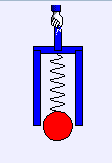
What happens when the cup is released?

What happens when the cup is released?
The Falling Cup with Ball model shows a mass attached to the inside of a cup with a light spring. The cup is held upside down, with the mass hanging out of the cup, then released from rest. What happens when the cup is released?
The weightless freefall of two masses connect by a spring appears in many physics demonstration catalogs and websites. Search the Physics Instructional Resource Association website for PIRA 1G20.40. A description of the apparatus and a video of this demonstration is available on the University of Maryland Physics Demonstration website.
Note: In addition to the spring force, the model incorporates a small viscous drag force on the ball and a the contact force between the ball and the cup when they collide.
The motion of the cup-mass system depends on internal (spring) and external (gravity) forces. Predict how the mass, the cup, and the system will behave before you perform the following computer experiments.
Explain your observations using Newton's laws.
Modify the Falling Cup with Ball model to display a small marker at the cup-ball center of mass. How does the center of mass marker move if the cup is being held? How does it move if the cup is falling? Can the center of mass move up if the cup is not being held?
Add a graph with three curves showing the positions of the cup, the ball, and the center of mass as functions of time.
The Falling Cup with Ball model was created by Wolfgang Christian using the Easy Java Simulations (EJS) modeling tool version 4.2. You can examine and modify the physical model for this simulation if you have Ejs installed by right-clicking within the wave function plot and selecting "Open Ejs Model" from the pop-up menu.
Information about EJS is available at: <http://www.um.es/fem/Ejs/> and in the OSP comPADRE collection <http://www.compadre.org/OSP/>.